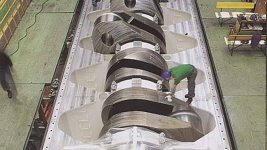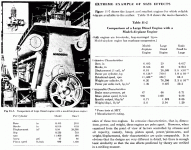Except for possibly transformers, most China Post diy audio supplies arrive on cargo converted 747 airliners. China has quite a few of them in service. They buy in bulk.
Easy to maintain and extremely reliable. They can do aerobatics too. I was on passenger service from Tokyo to Beijing and the Pla pilot did a cowboy stunt departing Narita airport. The 747 is impressive.
Easy to maintain and extremely reliable. They can do aerobatics too. I was on passenger service from Tokyo to Beijing and the Pla pilot did a cowboy stunt departing Narita airport. The 747 is impressive.
Thanks for that!...So in normal times, over 2 million bucks...
Wow, how many squeaky rubber ducky toys do you have to put on a container ship to amortise those 2 million bucks in fuel costs down to the point where you can sell the toy ducks for $1.25 each? 😱
And we're not even considering other shipping costs (crew, maintenance, depreciation, who knows what the heck else.)
-Gnobuddy
I heard the same thing, in fact, I actually mentioned it in my post #247 - its the very last sentence. 🙂I just heard that some ships are switching to LNG because its cheaper?
I had a friend with a pickup truck that ran on LNG. Range was poor, offsetting some of the lower fuel cost. Evidently the energy density of natural gas is quite a lot lower than the energy density of gasoline. But bunker fuel? The stuff is practically asphalt. Maybe LNG compares well to it?
Everything about those gargantuan engines amazes me.
I have been in phone-booths smaller than the interior of one cylinder of those engines.
Heck, there are Japanese hotel rooms about the size of the interior of one cylinder of those engines. 😱
-Gnobuddy
Confirmed cases in the USA jumped from 603 yesterday to 959 today. Three hundred and fifty six new confirmed cases overnight. 😱It might be that the 4 million kits may not be as useful as it sounds.
Info from Johns Hopkins U: Operations Dashboard for ArcGIS
Maybe those 4 million kits did a bit of good already?
-Gnobuddy
Gno - have you noticed the aging on Dr Bonnie Henrie’s face over just the past two weeks? She looks like she could use a long vacation, just not travel via airliner or cruise ship.
Feel free to make fun of Canada. I think I'll stock up on popcorn for when Trump starts a Twitter war with the CDC.
Feel free to make fun of Canada. I think I'll stock up on popcorn for when Trump starts a Twitter war with the CDC.
It's really not kind to berate the retarded, how crude of you! Poor guy can't even construct a coherent sentence.
---------------------------------------------------------------------Rick......
How's that for a crankshaft:
Honey I shrunk the mechanic.
The fun spec about the largest direct drive engine is full power is at 102 RPM.
Spot-on. All engines have similar piston speeds, adjusted for duty.
That BIG engine is a 145 inch stroke at 102rpm. 15,280-something.
Old Ford V-8 is 3 inch stroke rated 4,400rpm. 13,200-something.
My Honda is 3.8 inch stroke rated 5,500rpm. 20,900-something.
Model airplane engine is 0.5 inch stroke and 20,000rpm, 10,000-something.
(We traditionally say FPM, but that means more math, and "feet" is obsolete, so I just go by S*RPM=something.)
This works-out that the 20,000rpm engine is relatively SLOWER than my last two sedans, and the hotel-room engine is in the middle.
The model engine has several strikes against it. No timed ignition. Awful mix of explosive and thick fuel. Conservative and Cheap all over. I'm sure the better models hand-ported by an expert would turn much faster.
Attachments
Speaking of China selling, I searched for a buck boost converter and found one I was interested in, then noticed the orange banner at the top of the listing saying the seller was away for around three weeks and there would be an appropriate delay in mailing if you purchase...and then that the location was Wuhan! I must admit I can't remember seeing a listing from Wuhan before, but maybe I just hadn't noticed.
Doesn't durability play a role? Apparently those container-ship engines are not only expected to last 25 years, they are expected to be serviced in-situ; even the entire crankshaft can be replaced with the engine still in place in the ship!Spot-on. All engines have similar piston speeds, adjusted for duty.
In the V10 era of Formula One, somewhere around 2002, there was a BMW race engine that revved to over 19,000 RPM; stroke was around 42 mm, or 1.65 inches. RPM x stroke would have been over 31,000 inch-rpm. 😱
That engine was most definitely not designed to last for 25 years of operation!
-Gnobuddy
I live in La Boca, the old river port of Buenos Aires, 60 meters from the water, surrounded by Naval Supply shops, shipyards, ship repair shops and so on.
Typical is buildings with 3 to 5 story high doors so the large engines can be brought in, vertical as in the ship, I have seen monster crankshafts, and one just a block away has what I origibnally thought was a revolving platform, similar to what railroads have at critical points to turn locomotives around without maneuvering.
No, it is a monster Lathe, parts to be turned are placed **vertically** (the axis of rotation is vertical) and man sized tools come from the sides.
Typical is buildings with 3 to 5 story high doors so the large engines can be brought in, vertical as in the ship, I have seen monster crankshafts, and one just a block away has what I origibnally thought was a revolving platform, similar to what railroads have at critical points to turn locomotives around without maneuvering.
No, it is a monster Lathe, parts to be turned are placed **vertically** (the axis of rotation is vertical) and man sized tools come from the sides.
The model engine has several strikes against it. No timed ignition. Awful mix of explosive and thick fuel. Conservative and Cheap all over. I'm sure the better models hand-ported by an expert would turn much faster.
Are you sure?
For engine with side valve intake and exhaust ports, simple venturi throttle, glowplug ignition...
Have you seen how much Fractional horsepower a 0.12 Cu. In. 2 stroke makes?
And then compared it to what a 50cc 2 stroke dirt bike makes per cubic inch?
Model engine - Wikipedia
Now, efficiency...well that's another thing altogether.
It a little like the Wankel Vs Piston arguement - simple engine is more efficient at making power from small displacement, but less efficient when it comes to fuel, oil consumption.
A marine engine is almost the opposite situation, highest possible efficiency using said thick gloopy fuel.
One would probably find the HP per CI to be very very low in a marine engine.
Last edited:
- Home
- Member Areas
- The Lounge
- Supply chain broken?

